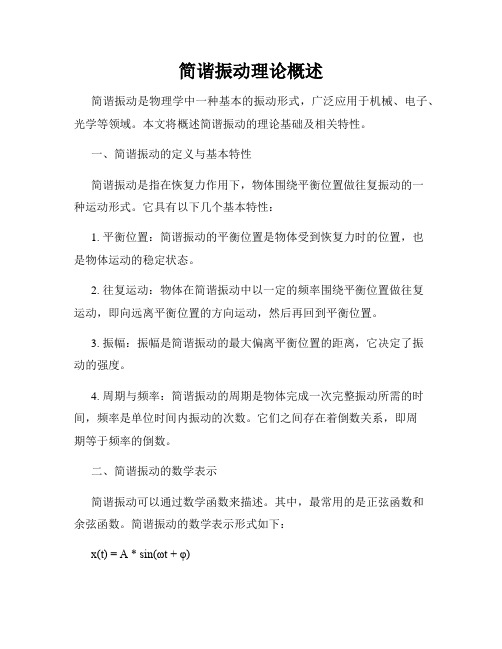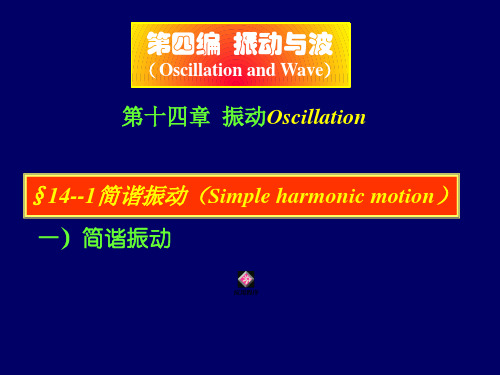Harmonic Oscillator(简谐振动)
- 格式:pdf
- 大小:307.70 KB
- 文档页数:8

分析简谐振动的几个概念简谐振动是指在没有阻尼和外力作用的情况下,系统绕平衡位置作周期性的往复运动。
简谐振动是物理学中一个重要的概念,涉及到许多重要的物理定律和实际应用。
在本文中,我们将分析简谐振动的几个概念,包括简谐振动的定义、特点、公式和实际应用等方面。
让我们来了解一下简谐振动的定义。
简谐振动是指一个系统在受到外力作用后,以一定的频率和幅度在平衡位置附近做周期性的振动。
简谐振动的特点是振动的周期、频率和幅度是不变的,而且振动的加速度与位移成正比,速度与位移成反比。
简谐振动的周期性和规律性使其在物理学和工程领域有着广泛的应用。
简谐振动的特点包括周期性、规律性和稳定性。
周期性是指振动的周期始终保持不变,也就是系统在做振动时,从一个极值点到另一个极值点所经历的时间是相同的。
规律性是指振动的频率和幅度也是不变的,无论受到什么样的外力作用,振动的频率和幅度都保持不变。
稳定性是指振动一旦开始,就会持续进行下去,直到受到外力作用或者系统本身的耗散效应使其停止。
简谐振动的公式可以用简单的正弦或余弦函数来描述。
对于弹簧振子和单摆来说,它们的简谐振动可以用如下形式的函数来描述:x(t) = A * cos(ωt + φ)x(t)是位移随时间的变化,A是振幅,ω是角频率,t是时间,φ是相位差。
该公式描述了系统在受到外力作用后,物体随时间做往复运动的情况。
简谐振动的公式可以非常准确地描述振动的规律和特性,因此在物理学和工程领域有广泛的应用。
在实际应用中,简谐振动有着广泛的应用。
在机械振动领域,简谐振动的特性被广泛地应用于机械结构的设计和分析中。
在电路领域,简谐振动的理论可以用于电路中的谐振电路的设计和分析。
在天体物理学领域,简谐振动的规律被广泛地应用于天体运动的研究中。
简谐振动的概念不仅是物理学理论研究的基础,而且在工程实践中也有着重要的应用价值。
简谐振动是物理学中一个重要的概念,具有着丰富的内涵和广泛的应用价值。
通过对简谐振动的定义、特点、公式和实际应用的分析,我们可以更深入地理解简谐振动的规律和特性,为我们在物理学和工程领域的研究和实践提供重要的理论基础和实际指导。


简谐振动理论概述简谐振动是物理学中一种基本的振动形式,广泛应用于机械、电子、光学等领域。
本文将概述简谐振动的理论基础及相关特性。
一、简谐振动的定义与基本特性简谐振动是指在恢复力作用下,物体围绕平衡位置做往复振动的一种运动形式。
它具有以下几个基本特性:1. 平衡位置:简谐振动的平衡位置是物体受到恢复力时的位置,也是物体运动的稳定状态。
2. 往复运动:物体在简谐振动中以一定的频率围绕平衡位置做往复运动,即向远离平衡位置的方向运动,然后再回到平衡位置。
3. 振幅:振幅是简谐振动的最大偏离平衡位置的距离,它决定了振动的强度。
4. 周期与频率:简谐振动的周期是物体完成一次完整振动所需的时间,频率是单位时间内振动的次数。
它们之间存在着倒数关系,即周期等于频率的倒数。
二、简谐振动的数学表示简谐振动可以通过数学函数来描述。
其中,最常用的是正弦函数和余弦函数。
简谐振动的数学表示形式如下:x(t) = A * sin(ωt + φ)其中,x(t)表示时间t时物体离平衡位置的距离;A表示振幅;ω表示角频率,与振动的周期和频率有关;φ表示相位,描述振动的初始时刻。
三、简谐振动的力学模型简谐振动的力学模型通常可以使用弹簧振子来描述。
弹簧振子由弹簧和质点组成,在无阻尼情况下可以实现简谐振动。
根据胡克定律,弹簧振子的恢复力与质点的位移成正比,可以通过以下公式表示:F = -kx其中,F表示恢复力的大小;k表示弹簧的劲度系数;x表示质点相对平衡位置的位移。
四、简谐振动的能量在简谐振动中,系统的总能量保持不变,由动能和势能组成。
质点的动能和势能在振动过程中相互转换。
动能和势能可以通过以下公式表示:动能 K = 1/2 * m * v^2势能 U = 1/2 * k * x^2其中,m表示质点的质量;v表示质点的速度;k表示弹簧的劲度系数;x表示质点相对平衡位置的位移。
五、简谐振动的应用简谐振动在各个领域都有重要的应用。
以下是一些常见的应用场景:1. 机械振动:简谐振动广泛应用于机械系统中,如弹簧振子、钟摆等。


振动与波动基础简谐振动的介绍振动与波动基础:简谐振动的介绍简谐振动是物理学中一种特殊的振动形式,它是指在没有能量耗散的情况下,系统围绕着平衡位置以固定频率和幅度做往复运动的现象。
在本文中,将对简谐振动的基本概念、数学表达以及应用进行介绍。
一、简谐振动的基本概念简谐振动的产生需要满足两个必要条件:恢复力与质量之间的线性关系,以及恢复力方向与质量位移方向相反。
当系统受到外力的干扰后,会发生简谐振动,回到平衡位置附近。
这是因为恢复力与质量的相互作用使得系统趋向于恢复正常位置,而来自外力的作用则使系统脱离平衡位置。
二、简谐振动的数学表达在数学上,简谐振动可以由谐波函数来表示。
谐波函数是一种正弦或余弦函数,能够准确描绘振动运动的特性。
以一维简谐振动为例,设物体的质量为m,恢复力的大小与质量位移的比例系数为k,则可以得到简谐振动的运动方程为:mx'' + kx = 0其中,x是位移函数关于时间的函数,x''是位移函数的二阶导数关于时间的函数。
该方程可以简化为:x'' + ω^2x = 0其中,ω是角频率,其大小与质量m和弹性系数k有关,可以用公式表示为:ω = √(k/m)通过解这个二阶非齐次常微分方程,我们可以得到简谐振动的解析表达式。
三、简谐振动的应用简谐振动在自然界和人类生活中有广泛的应用。
以下是一些常见的例子:1. 机械振动:例如弹簧振子、钟摆等,这些振动系统在物理实验和工程应用中广泛使用。
2. 光学振动:光学仪器中的激光器、晶体等也可以通过简谐振动模型进行分析和设计。
3. 电路振动:在电路中,简谐振动的模型被广泛应用于交流电路和振荡器的理论分析和设计。
4. 生物振动:生物体内的许多运动也可以通过简谐振动的模型来描述,例如心脏跳动、呼吸等。
总结:简谐振动是物体围绕平衡位置做往复运动的一种特殊形式,它的数学表达简洁清晰,并有着广泛的应用。
通过研究简谐振动,我们可以更好地理解物体的振动特性以及运动规律。

物理学简谐振动与波动理论物理学中,简谐振动与波动理论是两个重要的概念。
简谐振动是指一个物体在一个恒定周期内做无阻尼的周期性运动,而波动则是指在介质中传播的能量的传递过程。
本文将从简谐振动和波动的基本理论出发,探讨它们的性质和应用。
一、简谐振动简谐振动是一种最基本的振动形式,常见于许多物理系统中。
例如,弹簧的振子、钟摆和交流电路中的电感电容振荡器等。
简谐振动的运动是以某个平衡位置为中点,同时沿正负方向往返的运动。
简谐振动的特点之一是其运动方式是周期性的。
振子从一个极端位置出发,向中点运动,然后超过中点继续运动,再返回。
这种振动过程可用正弦或余弦函数来描述。
简谐振动的另一个重要特性是恢复力和加速度成正比,质量和位移成反比。
这个关系可以用胡克定律表示:F = -kx,其中F是恢复力,k是恢复力常数,x是位移量。
根据牛顿第二定律,我们可以得到振子的加速度与位移的关系为:a = -(k/m)x,其中m是振子的质量。
简谐振动的频率和周期与振子的质量和振幅有关。
频率的倒数被称为周期,用T表示。
简谐振动的频率和周期之间的关系可以用公式f =1/T来表示。
二、波动理论波动是物理学中另一个重要的概念,描述的是介质中的能量传递过程。
波浪、声音和光等都是常见的波动形式。
波动的基本特点是传播。
波动通过介质中的粒子间的相互作用而传播能量。
在波动的传播过程中,能量传递的速度被称为波速。
波速v 与波长λ和频率f之间的关系可以用公式v = λf来表示。
波动的类型有很多,常见的有机械波和电磁波。
机械波是需要介质传播的波动,例如水波、声波等。
而电磁波是一种无需介质的波动,包括可见光、无线电波等。
在波动理论中,振幅、波长和频率是三个重要的概念。
振幅表示波的最大位移,波长表示两个相邻波峰或波谷之间的距离,频率表示单位时间内波动的周期数。
三、应用与发展简谐振动和波动理论在科学研究和工程应用中具有广泛的应用。
简谐振动的应用包括钟摆的摆动、弹簧振子的共振等。
Harmonic Oscillator!X;516072910086F1607204Purposes of the measurement1.Get familiar with the air track,Jonly balance,and timing measurement device.2.Quantitatively study properties of the harmonic oscillator.Measurement PrincipleOscillation is the repetitive variation,typically in time,of some measure about a central value or between two or more different states.Harmonic oscillation is the simplest form of oscillation. Harmonic oscillation can be achieved easily with a spring system.Within elastic limit,the extension of the spring is proportional to the load applied to it:F=−kx(1) This is known as the w,where k is the spring constant.The spring constant can be measured by the so-called Jonly balance.A sketch of the device is shown below.After mounting the spring on the balance,one loads the spring with different amount of calibrated weights.Based on the displacement measured by the ruler scales on the device,one can measure the spring constant.Figure1:jonly balanceFigure 2:spring oscillatorThe scheme of the experiment is shown in Fig.2.An object with mass m is mounted on a horizontal air track.There are two springs with spring constants k1and k2,attaching to both sides of the object.The end of each spring is attached to one end of the air track.Let the origin of the motion be the position when the object is in equilibrium.If the object is displaced by an amount x,according to Newton .s Second Law of Motion,we haveM d 2xdt2+(k 1+k 2)x =0(2)The solution of takes a standard sinusoidal form (therefore the name /harmonic 0)x =Acos (ω0t +φ0)(3)where A is the amplitude of the oscillation,φ0is the initial phase,and ω0=k 1+k 2Mis the intrinsic angular frequency of the system.The period of the oscillation is given byT =2πω0=2πMk 1+k 2(4)When the mass of the spring cannot be neglected,we can quote the effective mass m 0=m 1+m 23,where m 1m 2are the mass of two springs.Then equation (4)can be written as T =2πM +m 0k 1+k 2(5)If friction is ignored,the mechanical energy of the spring and object system is conserved.the sum of the kinetic energy of the object and the potential energy of the spring is a constant.Sincethe potential energy of the spring is given by E P =12kx 2,and the kinetic energy of the object isE K =12mv 2.Let the amplitude of the oscillation be A,and the maximum speed of the object isvmax (when the spring displacement is zero),we havek =mv 2max A 2(6)Procedure1.Measurement of spring constants.(a)Adjust Jonly balance to vertical.Mount the first spring.Adjust knob /G 0to make themarker on the mirror,its image,and the marker on the glass tube aligned.Write down the initial displacement reading L1.(b)Load a known weight,and record the displacement L2.(c)Keep loading weight5more times,recording the displacement.(d)Use a least squarefit to determine the spring constant k1.(e)Repeat a)-d)on the other spring,and obtain k2.(f)Use an electrical balance to measure the masses of the springs.2.Study the relationship between oscillation period and the mass of the oscillator.(a)Adjust the air track to horizontal.(b)Attach two springs to the slide(with single blade),and let it oscillator about the opticalswitch for10periods.Record mass of the slide M1and oscillation period T1.(c)Keep adding weights,and repeat measurement in b)5times.(d)Plot M vs T2.(e)Fit the data points with k1+k2and an effective spring mass term m0?Compare k1+k2with stand-alone measurements in1.3.Study the relationship between oscillation amplitude and period.Keep the mass of the slidefixed,and vary the oscillation amplitude6times.Fit T vs A witha linear curve,and use the correlation coefficient R to look for correlation.4.Change the blade on the slide from single blade to U-shaped blade.Vary oscillation amplitude6times,and measure v max.Fit v2max vsA2according to Eqn.7to get the spring constant k,and compare with results obtained in1.Datamass measurementtimes of measurement m i/g M i/g1 4.699.592 4.789.803 4.759.574 4.809.695 4.859.696 4.839.85the mass of thefloating object is M=169.9gspring constantsK1times of measurement M total/g L/mm120.00 6.0224.6926.1329.4746.5434.2266.6539.0287.2643.87108.0748.70128.5K1=2.296N/mK2times of measurement M total/g L/mm120.0096.5224.69117.0329.47137.6434.22158.5539.02179.7643.87200.7748.70221.4K1=2.246N/mT2−M(M initial=171.0g)times of measurement M total/g10T/ms T2/ms2 1171.0012303.615137902180.5912629.015949203190.7912955.116783504199.9613263.417591805209.6513574.918427806219.3413872.719245207229.1914165.82006700 k1+k2=4.651N/m;R square=0.9999A−Ttimes of measurement A/mm T/ms192.51230.492142.51230.543192.51230.504242.51230.845292.51232.156342.51232.83So T is not related to Av2max−A2(∆x=9.90mm,M=182.0g)times of measurement A/mm∆t/ms A2/mm2v max=∆x∆t/ms−1v2max/m2s−2182.524.486806.250.4040.163 2102.519.8010506.250.5000.250 3122.516.5015006.250.6000.360 4142.514.0820306.250.7030.494 5162.512.3826406.250.8000.640 6182.510.9733306.250.9020.814 7202.59.9541006.250.9950.990 8222.59.0149506.25 1.099 1.208k m =24.43Nkg−1m−1;R square=0.9999 So the energy is conserved.damped vibrationtimes of measurement∆t/ms v max=∆x∆t /ms −1t/s 114.260.694 1.5381214.440.686 1.8457314.660.675 2.1533414.860.666 2.4609515.060.657 2.7685615.290.647 3.0761715.490.639 3.3837815.710.630 3.6913915.910.622 3.99891016.120.614 4.30651116.310.607 4.61411216.520.599 4.92171316.740.591 5.22931417.030.581 5.53691517.270.573 5.84451617.540.564 6.15211717.770.557 6.45971818.030.549 6.76731918.300.5417.0749β=0.136s −1Curves1.spring constantsFigure 3:K1m =kgx +x 0kg=0.2343(0.2339,0.2347)k 1=2.295N/mr =1Figure 4:K2m =kgx +x 0kg=0.2294(0.2284,0.2304)k 2=2.247N/mr =12.T 2−M curveFigure 5:T 2−MM =k 1+k 24π2T 2k 1+k 24π2=0.1178(0.1172,0.1183)k 1+k 2=4.651N/mAccording to the curve,when T=0,M should be -7.264g.So the equivalent mass is 7.264g,and m 1+m 23=7.043g ,so we can see equivalent mass as 13of the spring’s mass.3.T-A curveFigure 6:T −ASo T is not related to A.4.v 2max−A 2curveFigure 7:energy conservationv 2max =k 1+k 2M +m 0A2k 1+k 2M +m 0=24.43(24.18,24.68)r =0.9999So that m 0=8.381g5.damped vibrationFigure 8:damped vibrationlnv =−βln (k MA )t −βln (kMA )=0.04476(0.04423,0.04528)β=0.136s −1Conclusion1.K 1=2.296N/m,K 2=2.246N/m 2.T 2is proportional to M .3.T is not related to A.4.Mechanical energy is conservation in a harmonic oscillator.5.The equivalent mass of a spring is13of its mass.6.The damping factor βin this oscillator is 0.136s −1.。